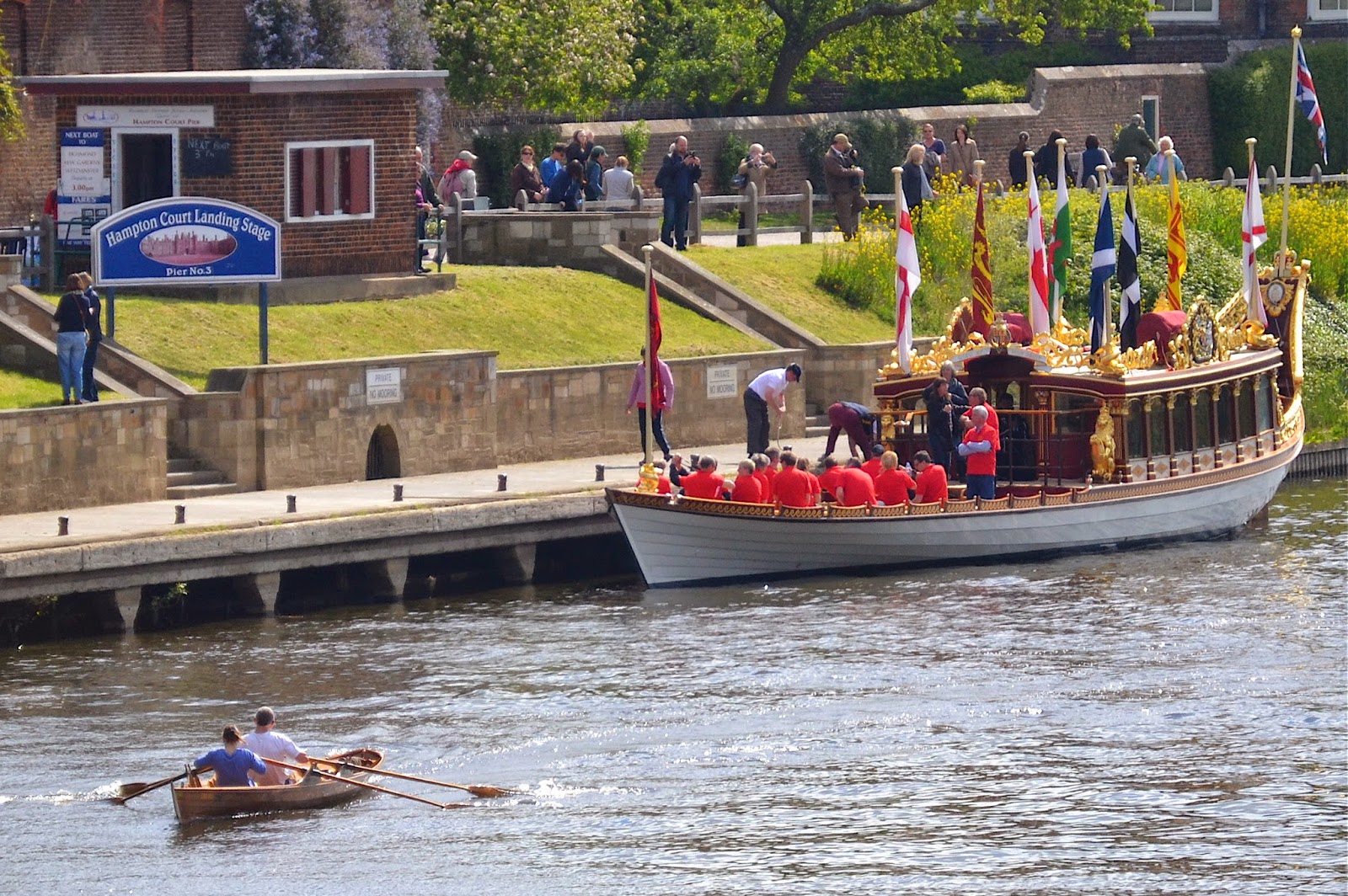Tim Koch writes:
This year marks the 300th anniversary of the establishment of the House of Hanover, the royal dynasty that ruled Britain and Ireland from 1714 to 1901, that is from the accession of George I to the death of Queen Victoria via the reigns of Georges II, III and IV and William IV. To mark the tercentenary, ‘Historic Royal Palaces’, the charity that looks after the Tower of London, the Banqueting House, Hampton Court Palace, Kensington Palace and Kew Palace, is organising a ‘Glorious Georges Season’. The Season consists of a series of events with the life of George I marked at Hampton Court, the life of George II at Kensington Palace and the life of George III at Kew Palace. Hampton Court was originally built for Henry VIII in 1514 and is sited on the Thames, 20 km from central London. Over the Easter holiday weekend, I was there to see ‘George I’ arrive in the Queen’s Row Barge, Gloriana, the magnificent vessel that HTBS has written about many times before.
Gloriana arrives at Hampton Court.
‘King George’ and his courtiers disembark.
George I (1660 - 1727) was a most unlikely British King. In 1714, at the age of 54, he had never been to Britain and ruled the lands belonging to the Hanover dynasty in Lower Saxony, now part of modern Germany. However, on the death of the British Queen Anne, George inherited her throne as he was her closest living Protestant relative. Although over fifty Roman Catholics had a closer blood relationship to Anne, the 1701 Act of Settlement prohibited Catholics from becoming Kings or Queens of Britain and Ireland.
History has not been kind to George but in recent years he and his reign has been seen in a more positive light. He was not popular with his British subjects who ridiculed him for his supposed stupidity and inability to speak English (though it is rather ironic that the largely monolingual English should criticise someone for not speaking a foreign language). In fact, George spoke good French and Latin and so had no problem communicating with important people. His shyness and the fact that ‘his heart was in Hanover’ may have been somehow interpreted as a lack of intelligence. Today he is seen as a progressive ruler in the Age of Reason, a time when ideas grounded in tradition and faith were challenged. During George’s rule the powers of the King diminished and Britain began the move to the system of government it has today. In the words of one biographer:
.....he ascended a precarious throne, and either by political wisdom and guile, or through accident and indifference, he left it secure in the hands of the Hanoverians and of Parliament.
Gloriana was not the only thing on the water at Hampton Court. These boats were from the nearby Kingston RC. Molesey BC is nearer to the Palace but its boats tend to stay upriver of this point on the other side of Molesey Lock.
The skiff is probably from Dittons Skiff and Punting Club based a little way downriver.
As an aside, most people tend to think of the Royal Family as the epitome of Britishness or Englishness. However, from 1714 to 1901, they were Hanoverians from the House of Brunswick and Lüneburg and, through Queen Victoria’s husband, were members of the House of Saxe-Coburg and Gotha, a branch of the House of Wettin, from 1901 to 1917. In the First World War the obvious German ancestry was a bit embarrassing and the totally made up name of ‘Windsor’ was adopted. On hearing this, it is alleged that the German Emperor said that he would like to see the Shakespeare play, ‘The Merry Wives of Saxe-Coburg-Gotha’. In more recent times, Queen Elizabeth’s husband, Prince Philip, is popularly supposed to be Greek/Danish, but he is a member of the House of Schleswig-Holstein-Sonderburg-Glücksburg. When the then Lady Diana Spencer married Queen Elizabeth’s son, Prince Charles, it was noted that she was far more British or English than he was. It could be argued that the Royals are as British as lederhosen made from bratwurst.
Strangely, when looking at the legacy of George I, most historians seem to concentrate on such things as Parliamentary Democracy and Cabinet Government or the forging of an anti-Spanish alliance and ignore his contribution to rowing, albeit a rather indirect one. In 1714, Thomas Doggett instituted a race with a prize of a coat and a silver badge to be rowed annually by six watermen within a year of completing their apprenticeships ...all which I would have to be continued yearly forever in Commemoration of His Majesty King George’s happy Accession to the British Throne...
George distrusted the conservative Tory Party and so the liberal Whig Party prospered under his rule and also for many years after. As a staunch Whig, Doggett was passionately devoted to the Hanoverians and laid down that the race was to be held each ‘1st day of August forever’ to commemorate the accession of George I on 1st August 1714, and had the 'running' White Horse, the symbol of the House of Hanover, embossed on the silver badge. Three hundred years later, the ‘Doggett’s Coat and Badge’ continues to be raced and the White Horse still adorns ‘The Badge’.
The 1982 Doggett’s winner, Gary Anness, at the 2013 Coat and Badge Race, showing the silver badge with the White Horse of Hanover commemorating the ‘happy accession’ of George I.
Malcolm Knight, the Events Manager for Gloriana, has more space than the average coxswain, but still uses a ‘cox box’ to give instructions to the eighteen rowers. As there is also a steersman in the stern, it could be said that there are two coxes on board – a rower’s nightmare.
Gloriana heads for home.
Photography © Tim Koch


.JPG)




















No comments:
Post a Comment